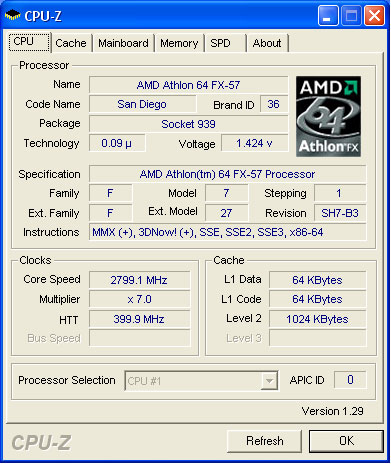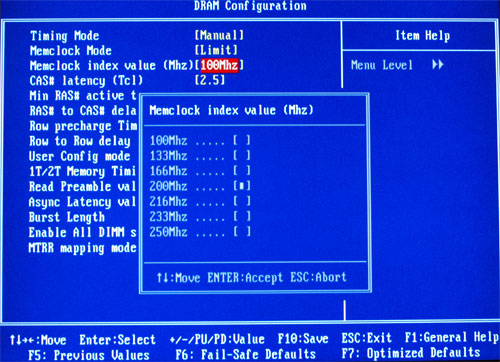ULi M1695 PCIe/AGP for Athlon 64 – Part 2 with SLI
by Wesley Fink on August 5, 2005 10:00 AM EST- Posted in
- Motherboards
Overclocking : ULi M1695/M1567 Reference 2
ULi tells us that they have improved overclocking on the Reference 2. Our OC tests confirm that claim.| ULi M1695/M1567 Reference 2 | |
| Clock Speed Overclocking | |
| Processor: | Athlon 64 FX57 (2.8GHz, 1MB Cache) Athlon 64 4000+ (2.4GHz, 1MB Cache) |
| CPU Voltage: | 1.55V (default 1.40V) |
| Cooling: | Thermaltake Silent Boost K8 Heat sink/Fan |
| Power Supply: | OCZ Power Stream 520W |
| Memory: | OCZ PC3200 EL Platinum Rev. 2 (Samsung TCCD Memory Chips) |
| Hard Drive: | Seagate 120GB 7200RPM SATA 8MB Cache |
| Maximum OC: (Standard Ratio) |
242x12 (4x HT, 2.5-3-3-10) 2904MHz (+21%) |
| Maximum FSB: (Lower Ratio) |
400 x 7 (2800MHz) (3x HT) (2 DIMMs in DC mode) (+100% Bus Overclock) |
In the first OC testing with the Reference 2, we really did no better with our 4000+ than our last efforts, which reached 300 in FIRST LOOK: ULi M1695 PCIe/AGP Socket 939 for Athlon 64. ULi suggested that we test with the FX57 for the 400 Clock Frequency, and this indeed worked for an incredible 400x7 clock speed.

The second possibility is the memory controller, with the FX57 having a much better Rev. E+. The memory controller for Rev.E is much improved, according to AMD, and the FX57 is the latest in the Rev. E memory controller family.
Regardless of the reasons why FX57 worked at 400, we are still left with the severe overclocking limitation of no voltages for memory in the ULi Reference 2 BIOS. We had to toss our normal overclock procedures out the window to bring you a better idea of the overclocking capabilities of this board. Without memory voltage, the only way that this can be tested is by lowering memory ratios to those that can run at default voltage. In this case, that would be a 100 setting on memory, so the 400 clock setting would yield a 200 base or DDR400 at the fixed memory voltage. ULi needs to correct this and provide memory voltage adjustments to 3.2V or more in production boards.
Due to the improved performance of the FX57 in overclocking, we plan to use the FX57 or another Rev. E Athlon 64, in future overclocking tests.











46 Comments
View All Comments
Wesley Fink - Saturday, August 6, 2005 - link
The 400 graph has been removed. After considering the questions here it is fair to say the ULi tests were not run under the same test conditions (due to no DDR Voltage controls and limited vCore adjustments) and should not be directly compared. The 242 remains since it was achieved with the same test conditions.Wesley Fink - Friday, August 5, 2005 - link
Yes, this is the only board using the FX57 in OC testing, but we will be testing with the FX57 in the future. Yes, that makes it an unfair comparison.It really was not possible to use our normal OC tests because the Reference board has no memory voltage adjustments at all. We stated this very clearly in the reviews. The option was to report very low results, or to make changes to the test to show how high the board could actually go in overclock (400 clock speed). We chose to show what the board could do on OC, but the results are not directly comparable to past results.
Lonyo - Friday, August 5, 2005 - link
OCZ BOOSTER FFS!!!!Aquila76 - Friday, August 5, 2005 - link
So if you want to run SLI, you have to use that riser card, right? How exactly does that fit in a standard ATX case? The cards are 90 degrees from their normal position. I understand that this is a good board if you're going to use older AGP cards and want an upgrade path; but I would think they could make it a lot cheaper if they left SLI capability off as it seems rather pointless in this format.kmmatney - Saturday, August 6, 2005 - link
I thought the same thing, but yes, its just a prrof of concept - the retail board makers will implement it without the need for a riser card.MarkB - Friday, August 5, 2005 - link
I think it's more of a proof of concept for showing off the chipset's capabilities, instead of making a whole new reference board to house the 2 x8 pci-e slots.I doubt any retail board would use the riser approach.
Sunbird - Friday, August 5, 2005 - link
Here is South Africa the ASRock 939A8X-m based in this ULi chipset has arrived at our local reseller last week.Its a mATX board and has SATA raid and all the other usual stuff. Near the bottom price range of the local market (aka cheap).
grug2k - Friday, August 5, 2005 - link
The AsRock 939AX-M is NOT a ULi M1695 board. It's an old AGP-only board based on the ULi M1689 chipset.lsman - Friday, August 5, 2005 - link
Computex2005 show also has Jetway A695DAG, Chaintech S1695-2WT - Friday, August 5, 2005 - link
This board should be on the short list (hehe, so short there is only one name on it) of boards for the DIY builder looking to keep their current AGP card and move to PCI Express down the road. There are a lot of users that fit that description so this board makes sense in every way. The only downside will be whether the boards are actually produced by some quality vendors who are not stuck on the Nvidia bandwagon.My S754 setup is adequate for any game that I play, so I should be able to make another year on it. After that, S939 and a 3800+ x2 makes more sense, but after buying that, I won't have the $ left to splurge on a mid-high end PCI Express video card. My 6800 cost $295 when I bought it, so moving that to the S939 setup makes financial sense.